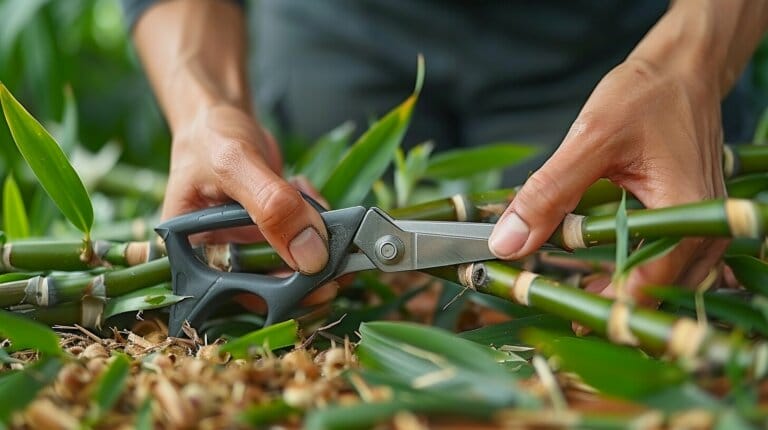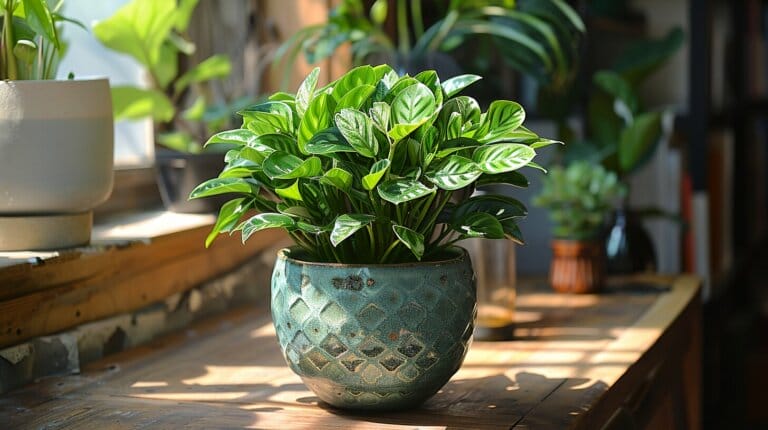Can You Plant Peace Lilies Outside: Quick Tips and Guidelines
Frequently, people inquire, ‘Is it possible to grow peace lilies outdoors?’
As a gardening enthusiast, I’ve struggled with this myself. Given the lily’s delicate nature, it’s not as simple as it seems. But don’t fret! I’m here to guide you through the process, sharing my firsthand experiences and tips to successfully grow these beautiful plants outdoors.
Let’s delve into the world of peace lilies and uncover the secret to their healthy outdoor growth.
Key Takeaways
- Peace lilies require a protected spot with filtered light when grown outdoors.
- They cannot tolerate cold temperatures or direct sunlight.
- Peace lilies adjust their water needs and light exposure when planted outdoors.
- Their ability to survive outdoors is limited to climates with mild winters.
Understanding the Growth Behavior of Peace Lilies

I’ve always been fascinated by the adaptability of peace lilies. Specifically, how they transition from indoor to outdoor environments.
Exploring their natural habitats and preferences is interesting, as these greatly influence their growth behavior.
I’m also curious about their lifespan and development in different settings, as it seems to vary significantly.
Unpacking the Plant’s Natural Habitats and Preferences
I’m exploring the peace lily’s natural habitats and preferences, and I’ve discovered that there are over 40 different species of this popular indoor plant.
Now, the question arises: Can you grow lilies outside? Here’s the scoop. Peace lilies are tropical, originally hailing from the rainforests of Central and South America. These plants thrive in warm, humid environments and prefer shady areas.
If you’re considering moving them outside, remember that peace lilies need a protected spot with filtered light. They can’t tolerate cold temperatures or direct sunlight. If you can mimic their natural habitat, you could indeed grow them outdoors. However, they’ll always need a little extra TLC to ensure they flourish.
How Peace Lilies Adapt from Indoors to Outdoors
In moving lilies outside, it’s vital to understand how they adapt from their usual indoor environment to a new outdoor setting. When you plant your peace lilies outdoors, they need some preparation. They’re not just houseplants; they’re tropical natives that can handle a bit of change.
They adapt by adjusting their water needs and light exposure. Indoors, they’re used to steady temperatures and indirect light. Outdoors, it’s a different story. Lilies grown outdoors must deal with fluctuating temperatures and varying light levels.
Outdoor lilies need well-draining soil and a spot with partial shade to thrive. They also need more water than their indoor counterparts, as they’ll dry out faster in the wind and sun. It’s all about understanding and catering to their needs.
The Lifespan and Development of Peace Lilies in Different Settings
Throughout my study, I’ve noticed that, over time, peace lilies show significant growth differences in indoor and outdoor settings, and it’s quite fascinating to observe. When I plant them outdoors, they bloom more frequently than indoors. Still, their overall lifespan is shorter due to weather conditions and pests.
Here’s what I’ve observed about how they grow best:
Indoors:
- Better control over temperature and humidity.
- Fewer pests lead to longer lifespans and development.
Outdoors:
- More frequent blooming but shorter lifespan.
- Increased exposure to pests and unpredictable weather.
Can You Plant Peace Lilies Outside? The Fact Check

I’ve been wondering if they can tough it out in the great outdoors. Let’s consider their temperature requirements, how seasonal changes might affect them, and understand any threats they might face in an outdoor environment.
It’s time we fact-checked the survival abilities of lilies outside.
Exploring Temperature Requirements for Outdoor Peace Lilies
I’m currently investigating whether they can survive in outdoor temperatures below 60 degrees Fahrenheit. It’s well known that they are sensitive to cold, but what exactly does this mean for outdoor lilies?
Here’s what I’ve found:
They need certain conditions to survive outdoors, including:
- Temperatures consistently above 60 degrees Fahrenheit.
- A location out of direct sunlight.
- Well-drained soil.
While exploring temperature requirements for outdoor lilies, it’s become clear that anything below 60 degrees can be harmful. Peace lilies’ ability to survive outdoors seems limited to climates with mild winters. I’ll continue my research to confirm these findings.
Please stay tuned for more updates on this fascinating topic.
Assessing the Impact of Seasonal Changes on Peace Lilies
Now, let’s assess how seasonal changes impact them and if they can really survive the harsh winters outdoors.
It’s essential to remember that they are sensitive to cold. This tropical plant prefers temperatures between 65 and 85 degrees Fahrenheit; anything below 45 can be harmful.
If you plan to grow lilies outdoors, they’re better off in pots so you can move them inside during winter. Lilies planted in the ground mightn’t survive the frost.
When assessing the impact of seasonal changes, you should also consider the plant’s need for high humidity and indirect sunlight. So, while they may endure a slight chill, the cold winter months could be too harsh for these sensitive plants.
Threats Peace Lilies May Encounter in an Outdoor Environment
In an outdoor environment, peace lilies face numerous threats, and it’s vital to understand these before deciding to plant them outside. They are sensitive plants, and proper care is required to protect your peace lily.
Here’s what you need to know about the threats they may encounter:
Temperature:
- They thrive in warm conditions.
- They’re sensitive to cold, and temperatures below 16°C can be harmful.
Light:
- They prefer indirect light.
- Direct sunlight can scorch their leaves.
Pests and Diseases:
- They’re susceptible to common pests like aphids and spider mites.
- Diseases like root rot can occur if the plant is overwatered.
Planting Guidelines: How to Successfully Plant Peace Lilies Outdoor

I’ve successfully planted lilies outside by carefully considering location, transplanting methods, and establishment practices.
It’s not enough to just plant them outside; you’ve got to choose the ideal spot and follow the right steps during transplanting.
Let’s talk about how we can make these beautiful plants thrive outdoors.
Choosing the Ideal Location to Grow Peace Lilies Outdoors
I’m determining the best spot in my garden to plant lilies outdoors. Choosing the ideal location to grow peace lilies outdoors isn’t as daunting as it might seem. These plants grow best in partially shaded, well-drained soil.
Here’s what I’ve considered in my garden:
Location to plant:
- A spot that receives morning sun but is shaded in the afternoon.
- A sheltered spot away from strong winds.
Soil conditions:
- Rich, well-draining soil is ideal.
- Soil pH should be slightly acidic.
Watering requirements:
- Keep the soil consistently moist.
- Avoid overwatering to prevent root rot.
Tips for Transplanting Indoor Peace Lilies to Outdoor Spaces
Here are a few tips I’ve learned for successfully transplanting indoor peace lilies to outdoor spaces, ensuring they get a strong, healthy start in their new environment:
- Identify a shaded area; excessive sun can damage them.
- Ensure the soil is well-drained; they don’t tolerate waterlogging.
- Plant lilies outside when temperatures are moderate, between 68-85°F.
Below, I’ve tabled vital transplanting guidelines to help them grow effectively:
| Task Ideal Condition | Why It’s Important |
| Sunlight Shaded | Prevents leaf burn |
| Soil Well-drained | Prevents root rot |
| Temperature 68-85°F | Ideal for growth |
Essential Steps in Establishing Outdoor Peace Lilies
After you’ve transplanted, it’s crucial to establish your lilies outside by consistently watering and feeding them, but also by monitoring for pests that can harm these delicate plants. Here are some essential steps in establishing outdoor lilies:
Watering and Feeding
- Maintain a regular watering schedule; lilies in the garden need constant hydration.
- Feed your plants with an appropriate fertilizer every six weeks.
Pest Control
- Regularly check for pests that could potentially harm your lilies.
Soil Management
- Select the right soil for your outdoor peace lilies. It should drain well while retaining some moisture.
Caring for Outdoor Peace Lilies: Keep Your Lily Plants Healthy

I’ve found that caring for outdoor peace lilies isn’t as daunting as it might seem.
It’s all about maintaining the right watering patterns, understanding their fertilization needs, and managing pests and diseases.
Let’s discuss these points to keep your lilies thriving outdoors.
Watering Patterns: Finding the Balance for Outdoor Peace Lilies
In my experience, getting the watering patterns right for outdoor peace lilies is crucial to ensure they remain healthy and vibrant. Peace lilies planted outdoors transpire at a higher rate than their indoor counterparts, making the task of finding the balance for watering a bit tricky.
Here’s my advice on how to water your peace lilies:
Understand Your Environment
- Keep in mind that weather conditions greatly influence watering needs.
- Remember that peace lilies in your garden need more water in hot, dry periods.
Check Before You Water
- Always touch the soil before watering. If it’s damp, wait a day or two.
Don’t Overwater
- Overwatering can lead to root rot, a common issue with peace lilies.
Navigating the Fertilization Needs of Peace Lilies Planted Outdoors
I’m now shifting focus to the fact that every single peace lily grown outdoors has specific fertilization needs that we must meet for optimal growth. As they are grown outdoors, they draw nutrients from their surroundings. If those nutrients aren’t available in the garden soil, we must supplement them.
The best location to plant lilies outside is a sheltered spot, where they’re protected but can still soak up the morning sun.
Navigating the fertilization needs of peace lilies is easier once we understand their natural habitat. In the wild, they exist in a nutrient-rich environment. So, when placing them in garden soil, it’s crucial to replicate these conditions. They need a balanced fertilizer, applied regularly, to thrive.
Managing Pests and Disease in Outdoor Peace Lilies
While providing the right nutrients for your outdoor peace lilies is crucial, managing pests and diseases that can potentially harm them is equally important. It’s key to understand the signs of distress to act promptly to ensure peace lilies can survive.
Here are some steps for managing pests and diseases:
Regularly inspect your plants. Look for:
- Discoloration or spots on leaves
- Signs of pests like aphids or spider mites
Create an ideal environment where peace lilies grow best in partially shaded spots. This includes:
- The right amount of water
- Proper drainage
Use safe and effective treatments. This could be:
- Organic insecticides
- Natural remedies like neem oil
- When you plant lilies outside, proper care ensures their survival and growth.
Common Pitfalls to Avoid when Growing a Peace Lily Outside

Growing a Peace Lily outdoors isn’t as simple as it seems, and I’ve learned this the hard way. I’ve had to combat root rot from over-watering and shield my lilies from harsh weather conditions.
And let’s not forget the challenge of finding the ideal location that won’t hinder their growth.
Preventing Root Rot and Over-Watering in the Outdoor Environment
I’ve found out that monitoring the soil’s moisture levels can help cut down on over-watering and the risk of root rot when planting lilies outside. The peace lily requires a balanced environment, not too dry nor too soggy. Over-watering in the outdoor environment can quickly turn fatal for lilies outdoors.
Here are a few strategies I’ve discovered to prevent these issues:
Choosing the right soil:
Use well-draining soil to avoid water retention.
Proper watering technique:
Water deeply but infrequently, allowing the soil to dry out between watering.
Regular monitoring:
Check the soil moisture levels regularly to prevent over-watering and root rot.
Safeguarding Peace Lilies from Harsh Weather Conditions
Not only do you need to ensure your peace lilies get enough water, but you also have to shield them from extreme temperatures and harsh weather conditions. Remember, peace lilies are sensitive to cold. As a tropical plant, they prefer warm, humid climates.
If you’ve planted your lilies outside where they can thrive, you must be prepared to move them inside during colder months. This is a key step in safeguarding them from harsh weather conditions. A sudden cold snap can damage or even kill these delicate plants. So, if frost is in the forecast, don’t hesitate to move them to a warmer location.
Proper care will ensure your peace lilies remain healthy and vibrant.
Avoiding Poor Location Choices that May Hinder Growth
I can’t stress enough the importance of choosing the right location for your peace lilies, as a poor choice could seriously hinder their growth. If you’re considering planting lilies outside, remember these plants are tropical and don’t thrive outdoors year-round in all climates.
Key location factors for peace lilies include:
- Light exposure: They thrive in bright, indirect light. Too much or too little light can hinder growth.
- Temperature: Peace lilies prefer temperatures between 65-85°F. Cold snaps can damage them.
- Humidity: These plants love high humidity; dry air can harm them.
Poor location choices could seriously affect their health and their survival, like placing them in direct sunlight or a dry, cool area.
After mastering the art of planting peace lilies outside, why not discover the secrets of growing lettuce indoors?
Frequently Asked Questions
What Type of Soil Is Best for Planting Peace Lilies Outdoors?
In my experience, peace lilies thrive best in well-draining, peat-based potting mix. They don’t like overly wet conditions, so the soil should retain some moisture but also allow for proper drainage.
How Often Should You Water an Outdoor Peace Lily?
When caring for an outdoor peace lily, I typically water it once a week. However, I’ll increase this to twice or thrice a week during hot, dry periods to keep the soil moist.
Are Peace Lilies Resistant to Pests and Diseases When Planted Outside?
I’ve found peace lilies fairly resistant to most pests and diseases, even when planted outside. However, they’re not immune and can still be affected, so regular checks are vital for their health.
Can Peace Lilies Survive in Direct Sunlight if Planted Outdoors?
I’ve found that peace lilies don’t fare well in direct sunlight outdoors. They prefer shady spots, as intense sunlight can scorch their leaves. It’s best to provide some shade when planted outdoors.
Can Peace Lilies Tolerate Cold Temperatures When Planted Outside?
I’ve found that peace lilies can’t tolerate cold temperatures when planted outside. They’re tropical plants, so frost can damage them. It’s best to bring them indoors if it’s chilly.
Conclusion
So, can you plant peace lilies outside? Sure, you can. But remember, they’re tropical plants that’ll need extra care to survive in different climates. Follow the planting guidelines to give them a good start, and watch for common pitfalls.
If you’re patient, diligent, and a little bit lucky, you might just be able to enjoy the beauty of outdoor peace lilies. It’s not easy, but it’s certainly possible.
Go ahead, give it a shot!







